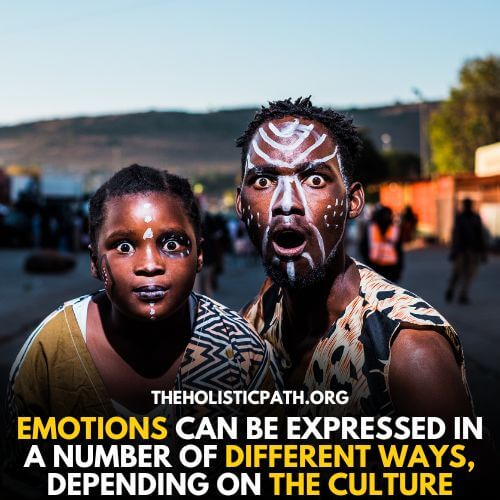How emotions differ across cultures is an interesting topic. When it comes to emotions, there is no one right way to feel them. Different cultures have their own unique ways of experiencing and expressing emotions, and this can sometimes lead to misunderstandings or conflict.
In order to avoid such problems, it is important to understand how emotions differ across cultures. The article explores five universal emotions and how they are expressed in different cultures. It also discusses the benefits of understanding culture-specific emotion displays.
How Emotions Differ Across Cultures- Five Universal Emotions
There are five basic emotions that are considered universal:
1. Anger-Universal Emotion:
Anger is a powerful emotion that can be expressed in many ways. It can range from feeling irritated to full-blown rage.
When someone is angry, their heart rate increases, and they may feel a sense of power or righteousness. Some people may scream, yell, or swear when they are angry. Others may become physically violent.
2. Universal Emotion-Fear:
Fear is a natural response to danger. When someone feels afraid, their body prepares to defend itself. This may include increasing heart rate, releasing adrenaline, and tensing muscles.
Fear can be expressed verbally through words like “I’m scared” or “I don’t want to.” It can also be expressed physically through actions like trembling or hiding.
3. Happiness-Universal Emotion:
Happiness is a positive emotion that is often characterized by feelings of joy, pleasure, and contentment. People who are happy tend to have a positive outlook on life and feel optimistic about the future. They may also smile and laugh more than usual.
4. Sadness-Universal Emotion:
Sadness is an emotional response to loss, disappointment, or suffering. When someone is sad, they may feel heavy hearted and downcast. They may also cry and express sorrow verbally or physically.
5. Universal Emotion-Disgust:
Disgust is an emotion that is triggered by something that is considered unclean, immoral, or offensive. When someone feels disgusted, they often have an intense reaction such as nausea, vomiting, or shaking.
Disgust can be expressed through words like “That’s disgusting” or “I can’t believe you did that.”
Each of these emotions can be expressed in a number of different ways, depending on the culture. For example, happiness may be expressed through laughter, smiling, or song, while sadness may be expressed through tears, silence, or anger.
So let’s first understand what emotions are and how emotions differ across cultures.

What Are Emotions And How Do They Differ Across Cultures
Emotions are mental states that arise from the interaction of our thoughts, feelings, and sensations. They can vary significantly from culture to culture, as different societies have their own unique ways of expressing emotions.
One of the most important things to understand about emotions is that they are not universal. What this means is that the way people experience and express emotions vary from culture to culture.
For example, in some cultures, it is considered acceptable to openly express one’s feelings, while in others it is considered rude or impolite to do so.
There are five basic emotions that are considered universal: happiness, sadness, anger, fear, and disgust. Each of these emotions can be expressed in a number of different ways, depending on the culture.

For example, happiness may be expressed through laughter, smiling, or song, while sadness may be expressed through tears, silence, or anger.
It is important to remember that cultural displays of emotion are not wrong or right – they simply reflect the norms of a particular culture. When interacting with people from other cultures, it is important to be aware of these differences and to respect the way they express their emotions.
Why Emotions Differ Across Cultures
Expressing emotions is not as simple as it may sound. Humans use a number of different cues to communicate emotions:
- Vocalisation
- Facial expression
- Posture or body language
It is these cues that make emotions differ across cultures. As people belonging to different cultures may use different cues to communicate the same emotions.
There are two schools of thought; the universalist camp and the socialist camp. The universalist camp believed that emotions are automatic, natural, and hard-wired.
Whereas, the socialist camp believes that though all humans share a common evolutionary heritage, different groups of people evolve to adapt to different environments. It is this adaptability that makes the emotions vary culturally.
What Makes Emotions Differ Across Cultures
One of the biggest factors that contribute to the way emotions are expressed across cultures is religion. For example, in some cultures, it is considered blasphemous to express certain emotions, such as anger or sadness, because they are seen as signs of weakness.

In other cultures, such as India, it is considered very important to express all of your emotions freely, even if they may be seen as negative. This can make it difficult for people from different cultures to understand each other’s emotional states.
Another factor that contributes to the way emotions are expressed across cultures is the level of individualism vs collectivism in a culture. Individualist cultures tend to emphasise the importance of the individual and their own feelings and needs.
While collectivist cultures emphasize the importance of the group and taking care of others. This can lead to different ways of expressing emotions, with individualist cultures tending to be more expressive and collectivist cultures tending to be more restrained.
How Cultures Shape Emotions
Cultures shape emotions in a variety of ways. One way is that different cultures have different norms for what is considered an appropriate emotional response.
Another way cultures shape emotions are by dictating which emotions are considered acceptable and unacceptable. Finally, cultures also shape emotions by dictating how people are supposed to express them.
Emotions in different cultures:
- How Emotions Are Expressed In East Asian Cultures:
East Asian cultures place a high value on maintaining harmony and avoiding conflict. As a result, East Asians often express their emotions in subtle ways. East Asians also tend to suppress their emotions in order to maintain harmonious relationships.
This can lead to emotional repression and difficulty expressing emotions openly. East Asians are more likely than other cultures to use emotion regulation strategies such as denial and suppression. East Asian cultures are also more likely to experience negative emotions such as sadness, anxiety, and shame
- How Emotions Are Expressed In Latin American Cultures:
Latin American cultures are highly expressive. Latin Americans tend to express their emotions directly and openly. They also use a lot of body language to communicate their emotions. Latin Americans are more likely than other cultures to experience positive emotions such as happiness, joy, and love
- How Emotions Are Expressed in Sub-Saharan African Cultures:
Sub-Saharan African cultures are very communal. People in Sub-Saharan African cultures tend to rely heavily on others for emotional support.
They also tend to express their emotions freely and openly. Sub-Saharan Africans are more likely than other cultures to experience negative emotions such as sadness, anger, and fear.
- How Emotions Are Expressed In North American Cultures:
North Americans place a great deal of emphasis on individualism. As a result, North Americans often keep their emotions bottled up inside.
They also tend to be less expressive than people from other cultures. North Americans are more likely than other cultures to experience positive emotions such as joy and happiness
Display Rules – How Different Cultures Show Their Emotions
When interacting with people from different cultures, it is important to be aware of their display rules – that is, the way they express their emotions. Each culture has its own unique set of display rules, which can be difficult to learn and understand.
One of the best ways to learn a culture’s display rules is to spend time with people from that culture. This will allow you to see how they express their emotions and what is considered acceptable in their society. It will also help you to build relationships with these people, which can be valuable in many ways.
Another way to learn about a culture’s display rules is through literature and film. These mediums can provide a great deal of insight into the emotions that are considered acceptable in a particular culture.

7 Benefits Of Understanding Emotions Across Cultures
There are many benefits to understanding emotions across cultures. Some of these benefits include:
1. It Can Help Us Build Better Relationships With the People Around Us.
When we understand the emotions that are driving the people around us, we can better relate to them and connect with them on a deeper level. This can lead to more meaningful and productive relationships, both at home and at work.
2. It Can Help Us Better Understand Ourselves.
When we understand the emotions that are influencing our own behaviour, we can better understand why we do the things we do. This can help us become more self-aware and make changes in our lives for the better.
3. It Can Help Us Deal With Difficult Emotions More Effectively.
Understanding the emotions that are driving our difficult emotions, we can deal with them more effectively. We can learn how to express them in a healthy way, and how to manage them in a positive way.
4. It Can Help Us Communicate Better With Others.
When we are aware of the emotions that are driving the other person’s words and actions, we can communicate with them more effectively. We can better understand what they are trying to say, and respond in a way that is more likely to be understood by them.
5. It Can Help Us Resolve Conflicts More Effectively.
When we understand the emotions that are driving both parties in a conflict, we can resolve it more effectively. We can see both sides of the issue more clearly, and find common ground that everyone can agree on.
6. It Can Help Us Build Stronger Relationships With People From Other Cultures.
By having an understanding of culturally specific emotion, we can build stronger relationships with people from those cultures. We will be able to communicate with them more effectively and understand their customs and traditions better.
7. It Can Help Us Be More Understanding Of People From Other Cultures.
Understanding the culturally specific emotions makes us be more understanding towards the people of those cultures. We will be less likely to stereotype or judge them unfairly and will be more open-minded towards them.
Conclusion-How Emotions Differ Across Cultures
Emotions play a major role in our lives and the lives of those around us. They are the glue that binds us together, and the expression of them is often what allows us to communicate with others. However, it is important to remember that emotions can differ drastically from culture to culture.
In some cultures, it is considered polite to keep your emotions hidden, while in others it is considered rude not to express them openly. This can lead to misunderstandings when people from different cultures interact.
The benefits of understanding how emotions differ across cultures are numerous. First, it can help prevent misunderstandings and conflicts between people from different cultures. Second, it can help us better understand our own emotions and why we feel the way we do.
Finally, it can help us better understand the emotions of those around us, which can make for more productive and satisfying relationships.
